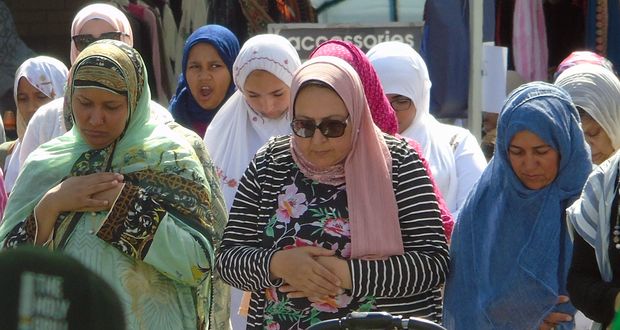Hijab – Individual Choice or Mandatory Duty Ordained by Allah? Islamic Heritage month is celebrated in Ontario every October. The Toronto District School Board (TDSB) issued a Resource Guidebook For Educators, that includes basic information about Islam and Muslims in Canada.
Approved by senior Muslim scholars and educators, this booklet provides to non-Muslim students background information about the hijab, a modest attire for Muslim women that includes a veil to cover the head, ears and the neck.
Here are excerpts from TDSB’s Resource Guidebook For Educators (2017):
What is Hijab? The hijab is a headscarf worn by some Muslim women who have reached adulthood as defined by the onset of puberty. The hijab is a piece of cloth that covers the hair, ears and neck, exposing only the face. The Arabic word khimar, as mentioned in the Qur’an, is a more traditional term used to denote the hijab. A minute sub-segment of Muslim women in Canada (estimated at less than a few hundred) choose to wear the niqab, which is a face covering in addition to the hijab. Women who choose to cover their heads are not exclusive to Islam; some Christian, Jewish, Sikh, Hindu, and Rastafarian women also wear a form of head covering as part of their religious or cultural practices. This theme is captured in the children’s book, Hats of Faith by Medeia Cohan-Petrolino.
Do all Muslim girls/women wear the Hijab? Female Muslim students may or may not wear the hijab, based on individual choice. Sometimes, they may wear the hijab regularly for a period of time, and then decide not to wear it. Many identity and societal factors are at play with regards to wearing the hijab – including parental pressure. In a popular Marvel comic titled, “Ms. Marvel”, one of the Muslim characters expresses her frustration when asked if her father forced her to wear the hijab, stating, “Actually, my dad wants me to take it off. He thinks it’s a phase” – an experience shared by some Canadian Muslim women (Wilson, 2014).
Shaikh Ahmad Kutty, a senior Imam at the Islamic Institute of Toronto, has a different view about the Islamic definition of the hijab and its application on Muslim women.
On his website www.askthescholar.com Shaikh Ahmad Kutty was asked:
“I have been wearing a hijab for as long as I can remember but to me it is just something that covers my head. I have decided that I no longer want to wear it. I am now an adult and so I would be facing the consequences of not wearing it. Does this make me less of a Muslim?”
Shaikh Ahmad Kutty issued an Islamic legal opinion on this matter:
“Hijab in the sense of modest attire for woman that covers the whole body excluding face and hands is ordained by Allah in the Qur’an. This is the understanding of the Muslims from the time of the Companions (the first addressees of the Qur’an) down through the centuries. There is not a single scholar or mufassir (interpreter of the Qur’an) of the past that I know who has questioned this ordinance. Once it has been proven to be the order of Allah, no Muslim or Muslimah can reject it on the ground that I am an adult, and I can decide for myself. Allah says: “When Allah and His Messenger have decided on a matter that concerns them, it is not fitting for any believing man or woman to claim the freedom of choice in that matter: whoever disobeys Allah and His Messenger is far astray.” (Qur’an: 33: 36). May Allah inspire us to see the truth as truth and follow it, and to see the error as error and shun it—aameen.”
A court case recently reported on by the Canadian Broadcasting Corporation (CBC) revealed how the Islamic ruling on hijab in practiced by Canadian families in Victoriaville, Quebec:
“A Quebec youth court judge has removed a 16-year-old girl in Victoriaville from her family after she was forced into a marriage with an older man who insisted she wear a hijab, rifled through her cellphone and controlled who she could see. The girl was so afraid in the weeks before the ceremony was to happen last spring that she ran to a neighbour’s house and locked herself in a bedroom. After a noisy and violent confrontation between the neighbours and the girl’s family, police escorted the girl to safety. In July, a youth court judge granted the girl’s request to be placed in hiding with a foster family until she turns 18.”

